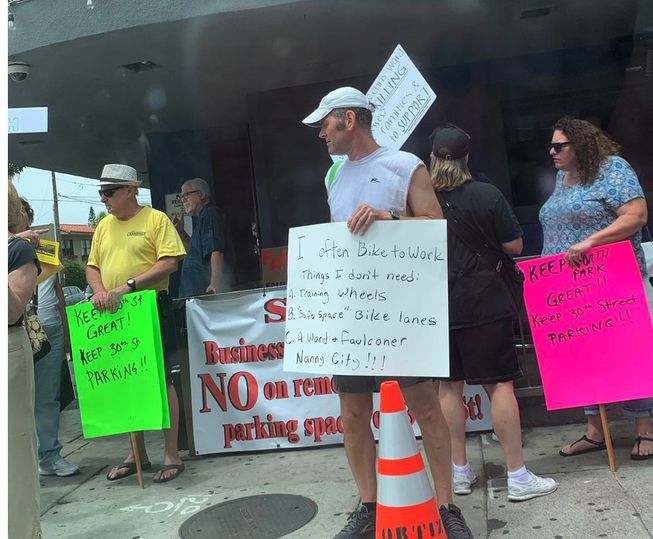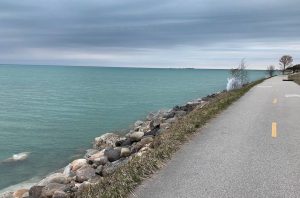On MNN: The year in urban design

Stories from TreeHugger’s sister site about how streets are for people.
Let’s just ignore the whole OK Boomer thing. I have written before that we are not in an intergenerational war, but a class war and a culture war. “In some ways, we would be better off if this was the last gasp of boomers trashing the place. In an intergenerational war, time is on the side of the young. Class wars are harder.”
But we cannot ignore that there are a lot of baby boomers in North America. Most are in pretty good shape right now, but in ten years, the youngest of the 70 million baby boomers will hit 65 years old and the oldest, 85 years old. On our sister site, Mother Nature Network, I have been writing about aging baby boomers, and what we have to do in our cities and communities to cope. I have picked a few of my posts that I think are most relevant to TreeHugger readers.
Walking while old is killing a lot more pedestrians than walking while distracted.
There are all kinds of distracted and compromised people in our roads. Some of them cannot help it.
At the most basic level, we have to stop this “distracted walking” nonsense, this stuff about headphones and hoodies.
Because while everybody is complaining about young people compromising their hearing and vision with smartphones, the fact is that a huge and growing proportion of our population is compromised by age. Drivers should be driving on the assumption the person in the road is not looking or seeing them, because they might not be able to.
Our roads, intersections and speed limits should be designed for this as well because it’s just going to get worse as the 75 million baby boomers age. I’m one of them — now legally a senior, and definitely a boomer. I’m fit because I bike everywhere, but I’m compromised.
We need a better word than ‘walkable’.
Streets also need to be rollable and strollerable and so much more.
Buildings on this stretch of Toronto street have a walkscore of 98.
But if you look at the actual sidewalk, it’s almost impassible on a nice day. The big raised planters take up half the sidewalk, and then retailers and restaurants take up even more space with tent signs, seating and more. Even the wonderful wheelchair ramps from the charity Stopgap, which make stores accessible for wheelchair users, become a trip hazard for anyone walking. On a sunny day, this street is not comfortably walkable for anyone, but it’s downright impossible for anyone with a walker or a wheelchair. It seems that unless you’re young and fit and have perfect vision and aren’t pushing a stroller or walking with a child, many streets in our cities aren’t walkable at all — even the streets that earn a Walkscore of 98.
Walkability isn’t enough; we also need:
Rollability. Walkability isn’t enough anymore. Or–
Strollerability, for people with kids. Or–
Walkerability, for older people pushing walkers. Or
Seeability, for the vision impaired. Our sidewalks have to do all of this. And we can’t forget
Seatability – places to sit down and rest, or
Toiletability – places to go to the bathroom. All of these contribute to making a city useable for everyone.
Why pedestrian deaths are a public health crisis
When lots of aging boomers start walking for transportation, we’re going to have a problem. (And remember, they like to vote.)
Where I live, the city is fast at plowing the streets, but sidewalks are the responsibility of the homeowner. It pushes people who don’t drive out into the streets.
It’s another example of an attitude that’s killing thousands of people every year, that puts the convenience of people in cars above the people who walk. As Matt Hickman notes in his post about the new Dangerous by Design report, pedestrian deaths are rising dramatically, up over 35 percent in 10 years in the United States. There are a number of reasons, including bad road design and the trend away from cars to bigger SUVs and pickup trucks, but one of the biggest is that the population is aging, and older people are more likely to die when their fragile bodies meet the front of a Ram 3500.
It’s why cities like Atlanta have to fix their sidewalks and cities like Toronto should plow them. “With an aging population, sidewalks are lifelines, and walking is the most important form of transportation. It can’t be ignored any longer.”
“Progressive” baby boomers are fighting housing and transportation progress.
My favorite protest sign complaining about a bike lane taking away parking in San Diego that encapsulated everything was: “Factory Famering [sic] creates more GHG than all the transportation in the world. GO VEGAN.”
Older, richer, often retired baby boomers have the time to show up at public meetings, and they tend to vote in large numbers and therefore get listened to….The craziest part of it all is that in a few years, these progressive boomers might well be wanting to rent an apartment in their own neighborhood. They might want to ride a bike or e-bike or mobility scooter to the store, as many older baby boomers are doing these days. They might even want to take a bus.
They are resisting inevitable change in their neighborhoods while ignoring the inevitable changes in their own lives, their own bodies. It won’t be long before this all comes back to bite them.
Falls may soon be the biggest cause of death.
But don’t call them accidents; most of them are completely avoidable.
The stair in the photo above almost killed my mother. Note how the only handrail is covered in bicycles and the treads are all dull gray. I tried to sue but they all said, “She was 96, get over it, people fall when they get old.”
But she didn’t fall because she was old. She fell because of bad design and worse maintenance. This is happening everywhere, and we are making the problem worse.
When 70 million baby boomers enter their 70s and 80s over the next 10 to 15 years, this is going to become a serious health crisis. In 2013, falls among older adults cost the U.S. health care system $34 billion in direct medical costs. Imagine what these numbers will be like when all the boomers are over 65. That might well be 20 million falls every year, probably more deaths than from cars or guns. So many that nobody will be able to roll their eyes and just say “it’s old people.”
You can blame the victim, and say old people will fall because they’re old and frail, or you can recognize this as a design problem, a maintenance problem, and a soon-to-be a very big problem as 70 million boomers reach this critical point in their lives.
Everyone on the road hates everyone else.
 Car on sidewalk and bike lane in Glasgow/ Lloyd Alter/CC BY 2.0
Car on sidewalk and bike lane in Glasgow/ Lloyd Alter/CC BY 2.0There’s a war on the bike, on pedestrians — and soon on old people.
Every time people try to stop a bike lane, they are suddenly worried about older people.
One approach used to delay or stop bike infrastructure is “concern trolling” where people are suddenly concerned about the safety of old people. Whoopi Goldberg did this recently on “The View”, when she complained that putting in bike lanes made it impossible for old people to park near where they shop or for ambulances to take them to the hospital, even though the vast majority of older New Yorkers walk everywhere and don’t drive and who would benefit from the better sidewalks and protected bike lanes that make streets safer for everyone.
In fact, most old people don’t drive, and need a different kind of infrastructure.
In 10 years, when the oldest of 70 million boomers are in their 80s, the drivers are going to have a lot more to complain about — millions of old people who take too long to cross the street, many more crosswalks and traffic islands taking up space, wider sidewalks and wider bike lanes to handle an explosion in the numbers of e-bikes and mobility devices. Unless we start planning now and figuring out how to share the space we have equitably, in 10 years it won’t be drivers hating pedestrians hating cyclists, it will be everybody hating old people. Because we will be everywhere.
Stories from TreeHugger’s sister site about how streets are for people.
Please enable JavaScript to view the comments.







